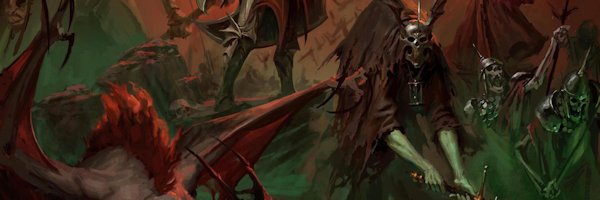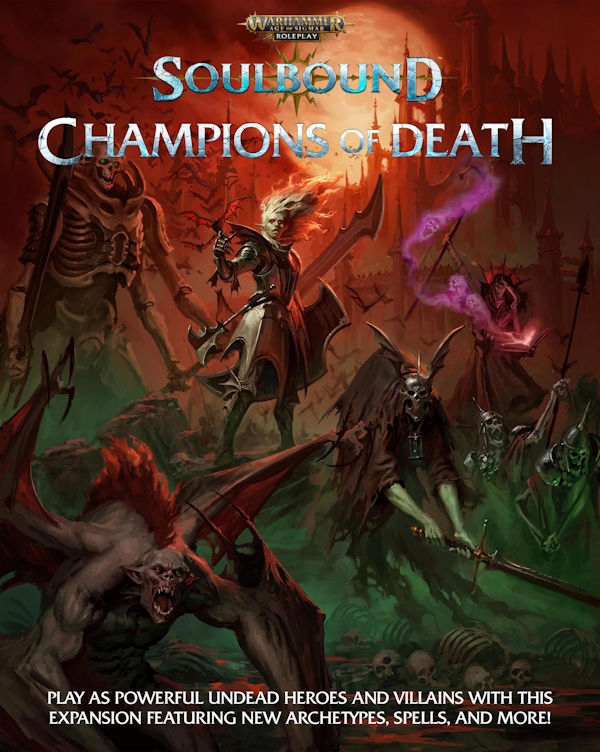 Writing: Emmet Byrne, Michael Duxbury, Cat Evans, Cody Faulk, Jordan Goldfarb, Elaine Lithgow, and KC Shi
Writing: Emmet Byrne, Michael Duxbury, Cat Evans, Cody Faulk, Jordan Goldfarb, Elaine Lithgow, and KC Shi- Editing: Christopher Walz
- Producers: Emmet Byrne, Elaine Lithgow
- Cover Art: Johan Grenier
- Illustration: Johan Genier, Álvaro Jiménez, Dániel Kovács, Sam Manley, Clara-Marie Morin, Rafael Teruel, Siman Vlaisavljevic
- Graphic Design and Layout: Rory McCormack
- Proofreading: Lynne M. Meyer
- Cubicle 7 Business Support: Tracey Bourke, Anthony Burke, Elaine Connolly, Andrena Hogan, Donna King, Kieran Murphy, and Cian Whelan
- Cubicle 7 Creative Team: Dave Allen, Emmet Byrne, Dave Chapman, Walt Ciechanowski, Tim Cox, Zak Dale-Clutterbuck, Cat Evans, Ben Fuller, Runesael Flynn, Dániel Kovács, Tim Huckelbery, Elaine Lithgow, TS Luikart, Rachael Macken, Rory McCormack, Dominic McDowall, Sam Manley, Pádraig Murphy, Ceíre O’Donoghue, JG O’Donoghue, Síne Quinn, and Christopher Walz
- Creative Director: Emmet Byrne
- Publisher: Dominic McDowall
- Warhammer Age of Sigmar: Soulbound designed by Emmet Byrne and Dominic McDowall
- Special thanks to Games Workshop
“Death is not the end. It is a terrible beginning.”
Champions of Death is a supplement for the Soulbound RPG that explores the first of the bad-guy super-factions (or Grand Alliances) in the Age of Sigmar setting. Given that the ‘good-guy’ Grand Alliance of Order includes heartless mercenaries, authoritarian conquerors, blood-murder cultists and literal soul-eaters, you might wonder how much worse things could get.
Pretty bad, to be honest. Nagash, supreme god of Death and Undeath, views all souls as his to punish, remake or recycle at will. And his will is cruel, merciless and eternal. For many servants of Nagash, the ultimate reward of being Soulbound is the chance to die (again) in battle and have their soul utterly annihilated, finally ending their eternal torment.
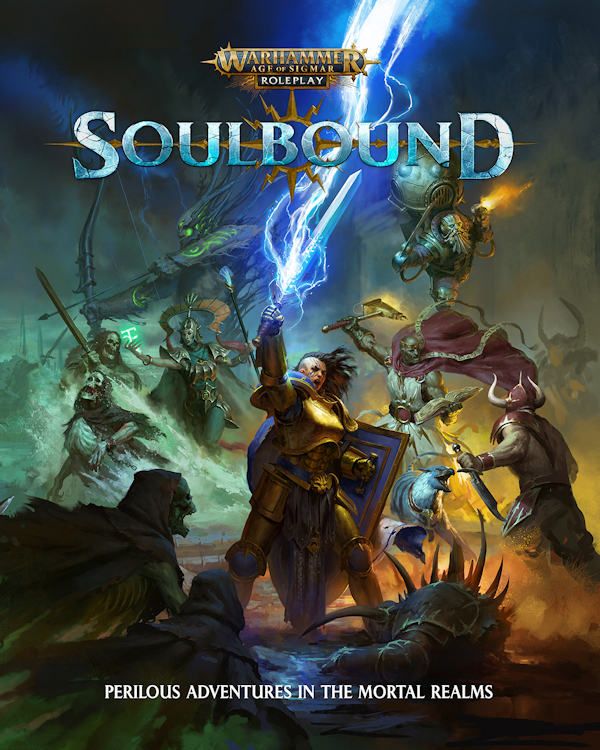 I’ve reviewed several Soulbound books already at this point. It’s my go-to RPG for epic fantasy these days. But for those who haven’t read my previous reviews, I’ll make a few quick notes here, please skip to the Introduction section if you’re already familiar with these books.
I’ve reviewed several Soulbound books already at this point. It’s my go-to RPG for epic fantasy these days. But for those who haven’t read my previous reviews, I’ll make a few quick notes here, please skip to the Introduction section if you’re already familiar with these books.
Soulbound books are always well laid out, with a good breakdown of concepts and rules, references to pages and books where you can get more information on a particular topic, a good ratio of art to text, helpful box outs and nice big titles to break up the text.
The Age of Sigmar setting is larger than life, both in the immense (near infinite) size of its eight Realms, and in its fun over-the-top characters, species and setting elements. This is a world of spooky sea-elves riding attack-turtles, steampunk flying cities and beasts so gigantic their bones form mountain ranges and skull-fortresses. I always feel like a hard rock or heavy metal band should be playing in the background of any Soulbound game.
From my limited perspective as a sheltered, white, British, cis-man—Cubicle 7 have shown an admirable dedication to promoting inclusivity in the hobby.
All of this holds true for Champions of Death.
Chapter 1. Introduction
Champions of Death mainly presents options to players for use in creating their characters and suggests two main styles of play.
You can portray a Binding created by Nagash or one of his Mortarchs (near god-like rulers of entire factions), to serve the cause of Death. This option is best for those who wish to revel in evil or portray lost and damned souls in a horrendous grimdark world.
The second option is literally called Unlikely Heroes and explores the idea of undead or Death-aligned champions who fight for Order. Such paragons may be vanishingly rare, but Soulbound is a game about exceptional individuals, so telling this kind of story is presented as a viable option.
There is the usual helpful explanation of what this book offers and how to use it. As well as some advice on using existing Soulbound products to flesh out the options given here e.g., how to reskin Talents to suit an undead party—a ghoul or vampire might provide their companions with fresh corpses to feast upon, rather than a home-cooked meal.
Chapter 2. Chosen of Nagash
This chapter briefly describes Nagash and his Mortarchs and how they view the art of Soulbinding. Nagash was instrumental in creating the original technique, alongside Sigmar, and used what he learned from the other gods of the original Order pantheon to create the Ossiarch Bonereapers—bizarre amalgams made from recombined soul fragments and repurposed bone.
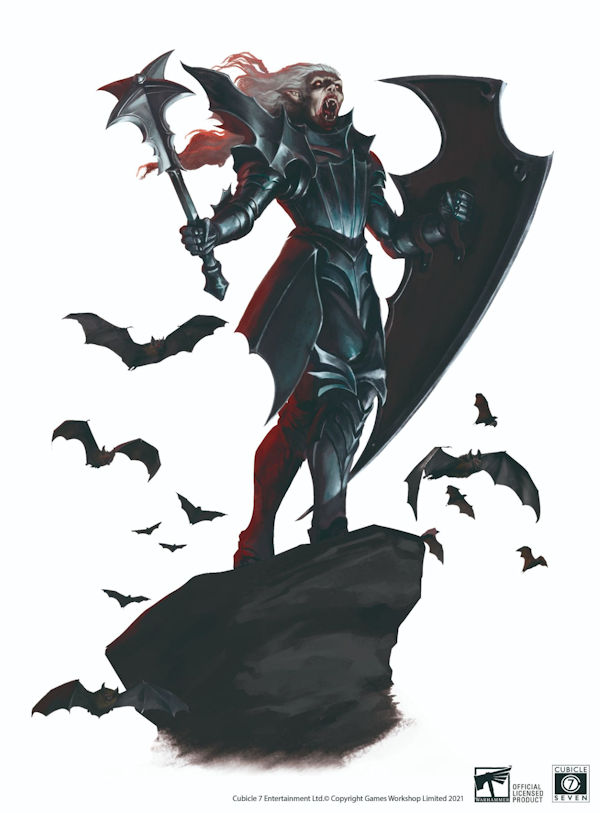 The Mortarchs are a seething collection of vampires, liches and ghosts, none trusting each other and some perhaps hoping to one day supplant their master. Still, they each wield a sliver of Nagash’s power and can create their own Bindings.
The Mortarchs are a seething collection of vampires, liches and ghosts, none trusting each other and some perhaps hoping to one day supplant their master. Still, they each wield a sliver of Nagash’s power and can create their own Bindings.
For the sake of narrative convenience, the Binding affects undead characters in different ways to the living. Soulbound undead regain a certain level of individuality and even humanity. This chapter also offers ideas and tables for generating motives for Death Bindings and characters: Hunt an escaped death god. Retrieve the bones of a long-dead godbeast. Defend a necropolis from a corpse-eating ogre tribe.
It also offers ideas and tables for creating vestiges of mortal life in undead characters and the insidious marks Death leaves on the forms of its living champions.
Your undead character: Cannot resist the allure of mirrors. Wants to swim whenever they can. Is haunted by the face of a loved one. Cares for animals, regardless of how animals feel about them. Obsessively collects coins.
Your living but Death-bound character: Stinks of rotting meat. Is constantly feverish. Has treacherous bones that occasionally try to jump out of their skin. Hears constant, near-imperceptible whispering.
There are long and short-term goals as well, broken down by species. The short-term goals are as you’d expect; some of the long-term goals are nigh impossible, such as unseating and replacing an existing Mortarch, or curing yourself of the Soulblight curse.
Chapter 3. Archetypes
This is what we’re all here for, right? Cool new creatures and powers to play with. I will pull from the Talents section in Chapter 4 in order to discuss the unique abilities of some Archetypes.
There are six Species presented in this book. Humans, ghouls, vampires, nighthaunts, wights and Ossiarch Bonereapers. Living humans are a rare sight in the armies of Death, but they can serve Nagash as Necromancers.
Ghouls
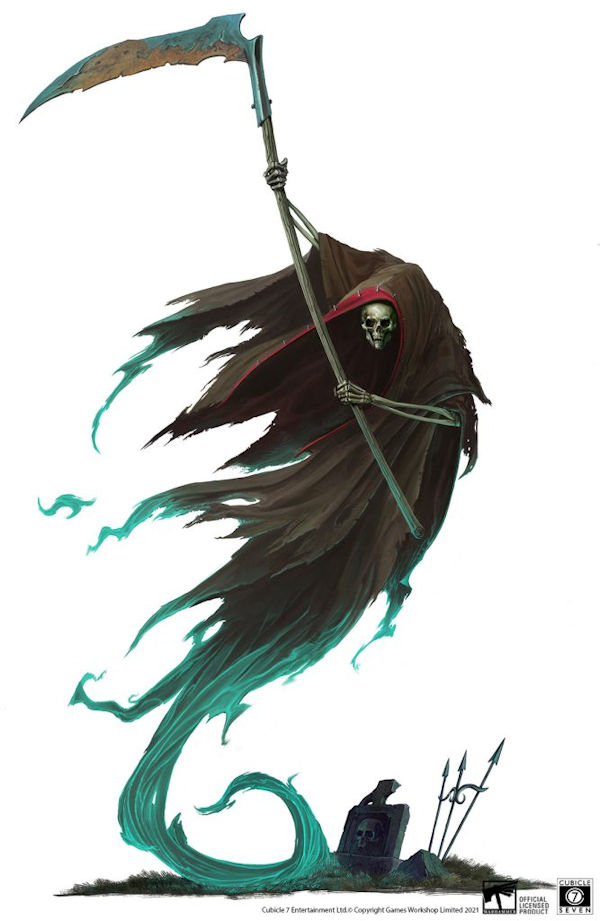 Ghouls are much as they appear in the Soulbound core book—depraved, devolved flesh-eaters who exist under the happy delusion that they are proud monarchs, dashing knights or beautiful courtiers. Soulbound ghouls must wrestle with these delusions, they gain extra Mettle by drawing upon their dreams of glory, but suffer dulled awareness as a consequence.
Ghouls are much as they appear in the Soulbound core book—depraved, devolved flesh-eaters who exist under the happy delusion that they are proud monarchs, dashing knights or beautiful courtiers. Soulbound ghouls must wrestle with these delusions, they gain extra Mettle by drawing upon their dreams of glory, but suffer dulled awareness as a consequence.
- Nighthaunts are vengeful ghosts, their souls captured by Nagash and twisted into new forms so they can serve him and suffer for eternity. Soulbound nighthaunts aren’t nerfed, which I appreciate—they can fly, pass through solid objects and take half damage from physical attacks. They’re not great at picking stuff up though.
- Soulblight vampires regenerate whenever they drink some tasty blood, and have a habit of draining their enemies mid-combat.
- Wights are sentient skeletal warriors, they are incredibly focused on one duty or task. They join the vampires and necromancers in the Soulblight Gravelords faction.
- The Bonereapers are Nagash’s vision for all souls—towering, many-armed, composite beings made from the torn apart and reassembled souls and harvested bones of many different dead mortals. They are still the most unique of the undead Species in this setting.
Ghouls, Bonereapers and Gravelords get their own unique sub-faction bonuses. The ghouls, or members of the Flesheater Courts, get some interesting extra detail here. They tend to see themselves as chivalrous empire builders, a cross between King Arthur and Charlemagne. They like to indulge in courtly intrigues, love affairs, gossip and gallant rivalries. In reality, they are shrieking hordes, presiding over endless slaughter and piles of bloodstained bones.
Interestingly, the Abhorrent Ghoul who rules a court defines their shared delusion, so they might actually believe themselves to be a nomadic tribe or an inhuman civilisation. Amusingly, their delusions of heroism make it easier for ghouls to cope with the psychological strain of rebelling against Nagash and joining an Order Binding. (Even as their unsanitary habits make it very difficult for them to make living friends.)
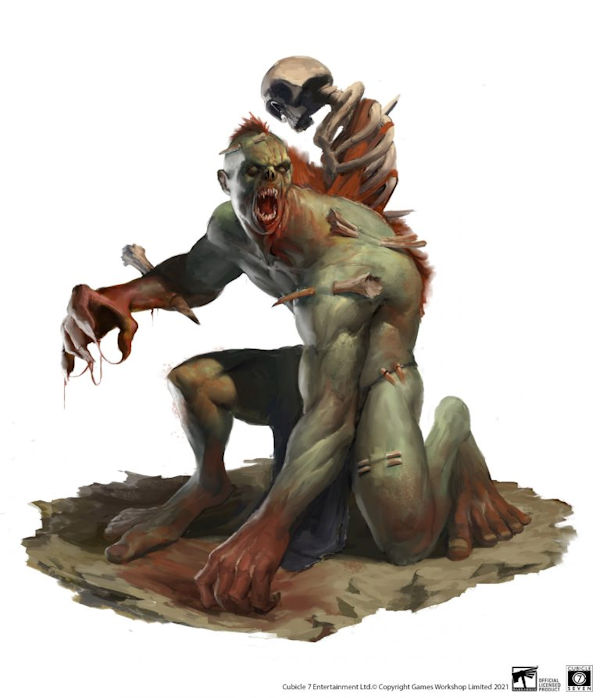 Particularly ‘heroic’ are the Hollowmourne, who see themselves as tragic yet noble knights eternally seeking lost treasures, while digging up graves and devouring the contents. And the Gristlegore, who consider themselves at one with nature, even as they consume all animal life they encounter. I do love the point that entire empires have been destroyed during the history of the Realms, and some may persist only as Ghoul Courts.
Particularly ‘heroic’ are the Hollowmourne, who see themselves as tragic yet noble knights eternally seeking lost treasures, while digging up graves and devouring the contents. And the Gristlegore, who consider themselves at one with nature, even as they consume all animal life they encounter. I do love the point that entire empires have been destroyed during the history of the Realms, and some may persist only as Ghoul Courts.
Archetypes on offer include:
- The Abhorrent Ghoul: rulers of the Courts, they are actually vampires, with the associated powers and a talent for magic.
- Crypt Ghast Courtier: they see themselves as professional soldiers and serve as officers, guiding other ghouls into battle.
- Crypt Haunter Courtier: big lumbering monsters.
- Crypt Infernal Courtier: winged ghouls. They serve as advance scouts. The ghouls see them as winged saints or Pegasus riders. They are equipped with talons and very bad breath (Zombie Dragon breath to be precise).
Nighthaunts
Once rare, their numbers exploded after the Necroquake. (Let’s not go into that properly here, Nagash did a bad thing and damaged the fabric of the Realms in the process, this caused the Necroquake and now there are ghosts everywhere.) Nighthaunts travel in vast funeral processions or armies. They are uniformly vengeful, tortured, and hateful. Each nighthaunt has a form and punishment that fits its ‘crimes’, which could be anything from enjoying killing too much to healing the sick, and thus denying the God of Death his due. Nighthaunts are the most likely to join a Binding in the hope of being erased from existence.
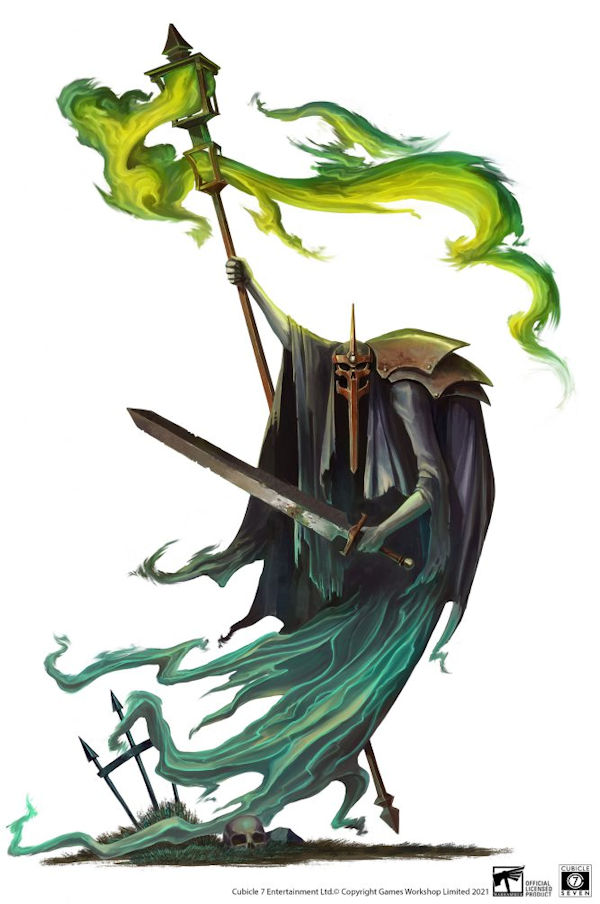 No one is having a good time when the nighthaunts turn up, including them. Quite a few nighthaunt abilities riff off causing the Fear status and profiting from it. For example, Myrmourn Banshees eat spells, but doing this is very painful for them, and their agonised wails can Frighten those who hear them. Cairn Wraiths are dead serial killers with big scythes who inflict extra damage on Frightened creatures.
No one is having a good time when the nighthaunts turn up, including them. Quite a few nighthaunt abilities riff off causing the Fear status and profiting from it. For example, Myrmourn Banshees eat spells, but doing this is very painful for them, and their agonised wails can Frighten those who hear them. Cairn Wraiths are dead serial killers with big scythes who inflict extra damage on Frightened creatures.
All of the nighthaunts present great visuals, with wonderfully unique and intimidating art:
- The Lord-Executioner: wears the shrieking, angry souls of their many victims as armour.
- The Knight of Shrouds: a general who betrayed their army to Death, calls to mind a mounted Ring Wraith. (Also, doesn’t that sound like a card in a gothic Tarot set?)
- The Guardian of Souls: a dead necromancer who must now shepherd the souls they thought to steal from Nagash, wears a giant metal mask and carries an eerie green lantern.
“The spirit’s lantern shone with a light that illuminated nothing. Its smoke spilled down rather than floated up.”
- The Spirit Torment: a former jailor, now they wear a blank mask, carry a gigantic padlock and imprison their fellow nighthaunts, failing to see the irony of their own captivity.
“The ultimate destination for those captured by Spirit Torments is the Great Oubliette, a prison-continent entombed beneath Shyish’s surface, made of miserable, icy dungeons.”
Occasional flashes of, very faint, hope can be seen amongst the spectral ranks of this incredibly bleak faction. A Knight of Shrouds may seek redemption for their betrayal. A Guardian of Souls might secretly study the magics they knew in life, seeking some way to unravel the ties that bind them to Nagash’s service. Even the universally despised Spirit Torments may come to realise they are in the best position to seek freedom for themselves and others.
Ossiarch Bonereapers
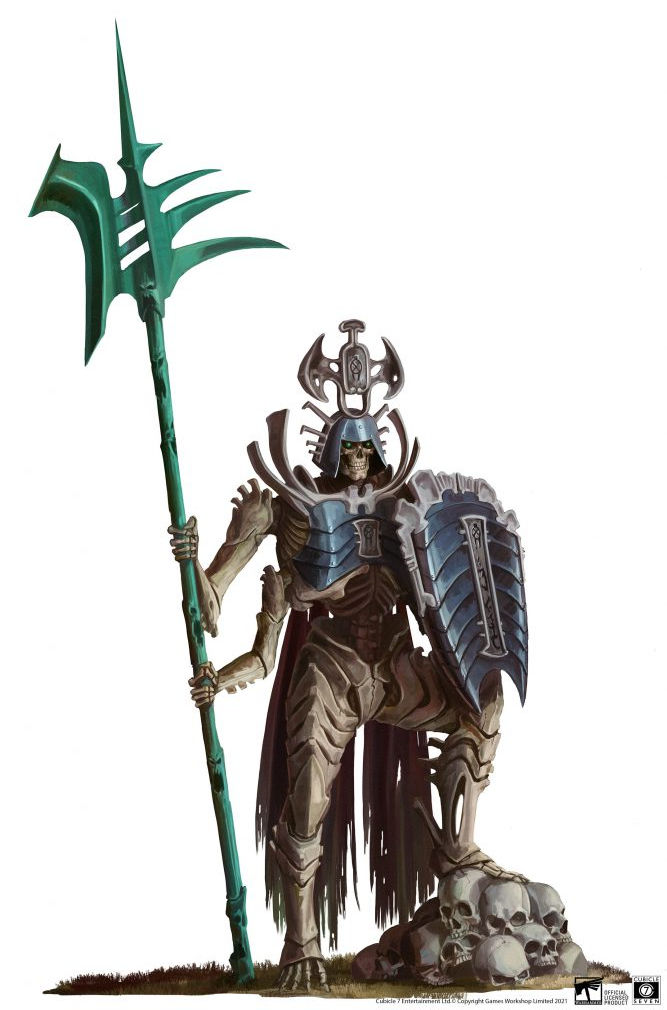 Nagash’s ‘perfect’ creations are built with pride and ambition but no sense of passion or self-preservation. They carefully monitor each other for human failings such as love or hate; even these paragons of Death may find themselves becoming more individual, or even rebellious. Perhaps the Great Necromancer’s ultimate experiment is doomed to fail. In the meantime, the Bonereapers are a terrifying scourge upon the Realms.
Nagash’s ‘perfect’ creations are built with pride and ambition but no sense of passion or self-preservation. They carefully monitor each other for human failings such as love or hate; even these paragons of Death may find themselves becoming more individual, or even rebellious. Perhaps the Great Necromancer’s ultimate experiment is doomed to fail. In the meantime, the Bonereapers are a terrifying scourge upon the Realms.
There is no upward mobility in the rigid Ossiarch caste system. Though Bonereapers who fail their tasks can be demoted to lower castes, their bodies remade into different forms that suit their new station. It’s actually possible to be demoted to the rank of horse! Which makes a great back story for a character’s steed.
- Ossiarch sub-factions include the Petrifex Elite, who only use fossilised bones to make and repair themselves and loathe individuality.
“They go only by titles, such as the Grand Necromystic, the Thrice-Sculptor, and the Sinistral Master, but some have accumulated such infamy that these titles are as good as names.”
- Then there are the Null Myriad—eerie, magic eating guardians of the edges of reality, they are more likely to fight Chaos than Order.
- Or the Crematorians, who are always on fire.
 Onto Archetypes:
Onto Archetypes:
- The classic Bonereaper is the Immortis Guard, big skeletal giants with big shields and halberds.
- Kavalos Deathriders are big skeletal knights, they view other undead cavalry as rivals and hunt their prey relentlessly.
- Morghasts are flying, feral-faced creatures, born to spread fear. Their origin is shrouded in mystery, but probably involves quite appalling things being done to the souls of those mortals who have most displeased Nagash, such as the Stormcast Eternals.
- Mortisans make and repair other Bonereapers. Their magic is similar to the Ritual of Soulbinding, so they may accompany a Binding out of professional curiosity.
- Necropolis Stalkers guard the necropolises of other Death factions. Otherwise, they are best described in the authors’ own words:
“You have four faces, four arms, and four souls, each taken from a master in a different fighting style.”
Soulblight Gravelords
I described this faction in a previous review as the traditional undead and less interesting than the other Death armies. They get a bit more depth and interest here. Of particular note is this faction contains many different kingdoms, lineages and Species. Each Gravelord pursues their own bloodthirsty amusements, with Nagash seemingly happy to leave them to their own devices until he needs to call on their services. Consequently, they are a seething morass of betrayal and conquest, the perfect recipe for grimdark adventures!
 Soulblight vampires in particular are afflicted by more than just a thirst for blood; the curse makes them callous and narcissistic as well as predatory. Nonetheless, their independence, powers of regeneration and ability to pass as human make them valuable additions to a Death Binding.
Soulblight vampires in particular are afflicted by more than just a thirst for blood; the curse makes them callous and narcissistic as well as predatory. Nonetheless, their independence, powers of regeneration and ability to pass as human make them valuable additions to a Death Binding.
The two Vampire Mortarchs, Neferata, who leads the Legion of Blood, and Mannfred, who leads the Legion of Night, do not get on.
“The Legion of Night, which specialises in brute, ever-growing force, and the Legion of Blood, which prefers military intelligence and espionage, dominate the Soulblight political landscape. Nominally they serve the same master, but their relationship has always been tense and a recent betrayal by Mannfred’s Legion of Night has made hostilities explicit.”
Three other vampire dynasties are presented here too, and I love them all.
- The Vyrkos are wolf-like vampires who see themselves as great hunters and use pack tactics in battle.
- The Kastelai are spiritual successors to the Blood Dragons of Warhammer Fantasy: vampire knights who profess to be noble but are as bloodthirsty as any other night-creature. They are bound to a teleporting castle, possibly inspired by Dracula’s castle in Castlevania.
- By contrast, the Avengorii are monstrously devolved vampires who embrace their own twisted forms but may actually have preserved more of their mortal honour than the Kastelai.
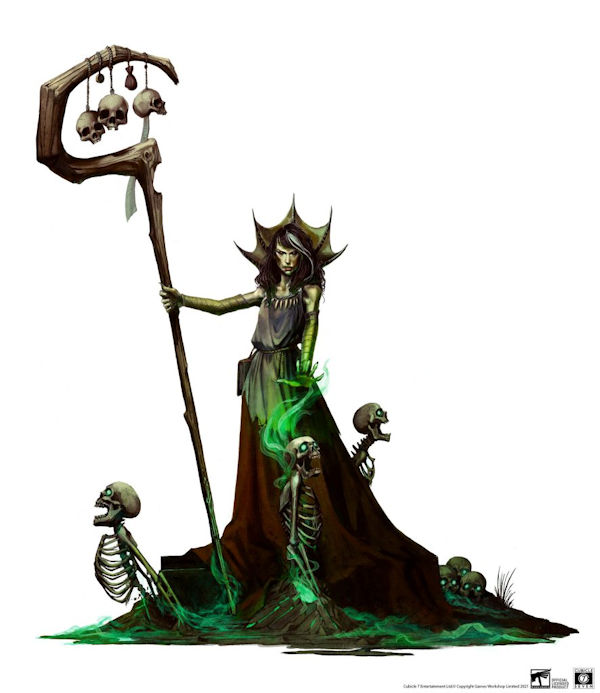 Gravelord Archetypes are as follows:
Gravelord Archetypes are as follows:
- Black Knights are actually Wight knights. (I’ll see myself out.) Though lacking the spectral flight of a Knight of Shrouds or the towering form of the Kavalos, they are intensely dedicated to their duty, gaining a free Charge Action in any Round where they pursue it.
- Grave Guards, on the other hand, are harder to destroy when following their duty.
- Blood Knights are vampire knights. Though vicious and in love with battle, they maintain complex and unique codes of honour. They also have a brilliantly spiky and baroque portrait.
- Necromancers are mortal Death Mages; they can potentially learn any of the Lores of Death and get an interesting description.
“The Amethyst Battlemages of the Collegiate Arcane are quick to draw the line between them and Necromancers. A Necromancer knows no limits. They dig up corpses and dissect them still in their coffins, they experiment on the living and use gags of sinew to muffle their screaming, and they stitch together abominations.”
- Vampire Lords have extremely high stats, wield vampiric magic and can learn any Skill they wish.
Chapter 4. Talents and Miracles
The Talents offered here nicely showcase some of the unique features of undead characters, and the particular selling points of the different Species. Here’s a taste of some of those abilities.
Bonereapers can carry extra weapons in their extra arms, and some of them are made from bones infused with Death magic, granting them bonuses to their casting.
Vampires can fall into a battle rage at the sight or smell of blood, or turn into wolves or swarms of bats (that Talent functions quite like a Druid’s Wildshape ability in D&D). They can also succumb to their monstrous nature and allow it to manifest as physical changes such as bat wings or wolf legs.
Nighthaunts can feed on fear, teleport or get free attacks against creatures that damage them.
Ghouls can sprint “gallantly” into battle with unnatural speed or shrug off conditions that would stun the living.
Any undead could have a hatred for the living so strong it grants them bonuses to bullying them. Or benefit from the accumulated wisdom of thousands of years (either from their own experience or from the souls they have captured), gaining bonuses to combat or non-combat Skills. (I did appreciate that acknowledgement of the difference in scale of knowledge between the living and the Dead.) Undead can also gain the ability to escape from grapples by ripping their own arms off, which seems extreme but then it’s an extreme sort of game.
Overall, it’s a ghastly and gruesome array of powers I thoroughly enjoyed reading.
Miracles
The undead only have one god: Nagash.
His Miracles include the ability to raise zombies or skeletons, of course, but also to age a target or snuff out their life. One particularly unpleasant ritual lets the caster steal a fresh corpse’s face.
More pleasant, but just as thematic is “All Are One”, a Miracle that allows the caster to teleport between graves or bodies, because all are one in Nagash’s eyes.
Chapter 5. Spells
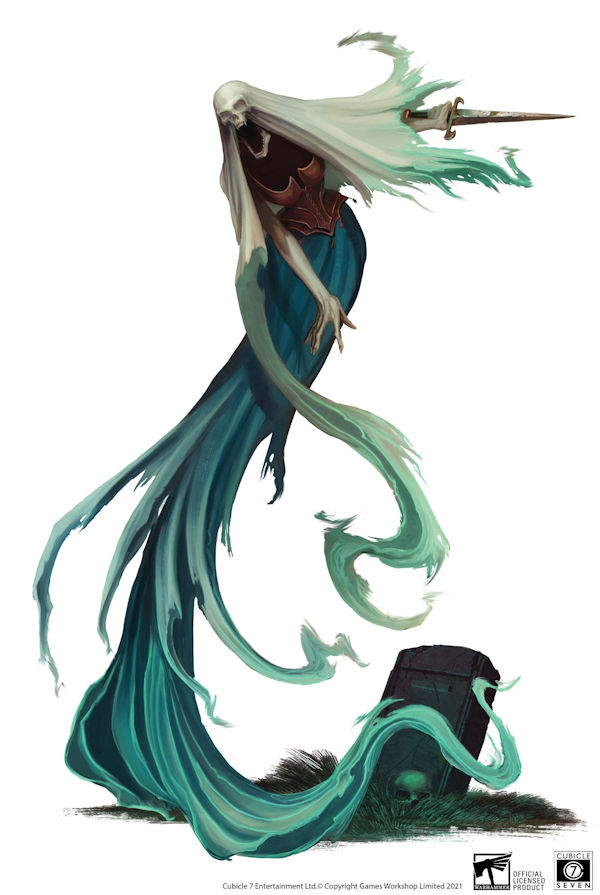 In contrast to their limited options for Miracles, the undead have a lot of Lores of Magic at their disposal. Deathmage (AKA Necromancy), Madness (AKA Ghoul magic), Mortisan, Underworld (AKA nighthaunt magic), and Vampire.
In contrast to their limited options for Miracles, the undead have a lot of Lores of Magic at their disposal. Deathmage (AKA Necromancy), Madness (AKA Ghoul magic), Mortisan, Underworld (AKA nighthaunt magic), and Vampire.
Deathmages seem to copy some of the powers of Nagash—they can weaken their enemies by sapping their youth, strength or hope. They have a couple of great spell names—Decrepify and Vanhel’s Danse Macabre (Danse Macabre was a classic spell from Warhammer Fantasy, it increases the speed of undead creatures, but doesn’t actually make them dance). And, of course, they can raise zombies.
The Lore of Madness has more to do with ghoulishness than it does insanity. I think the writers just created the grisliest Spells they could imagine. Ghoul Mages can tear blood from a target and use it to heal an ally, power up their allies, or detonate bones (a very Diablo ability). They can eat a corpse’s brain to steal its memories or inflict cannibalistic hungers upon their enemies.
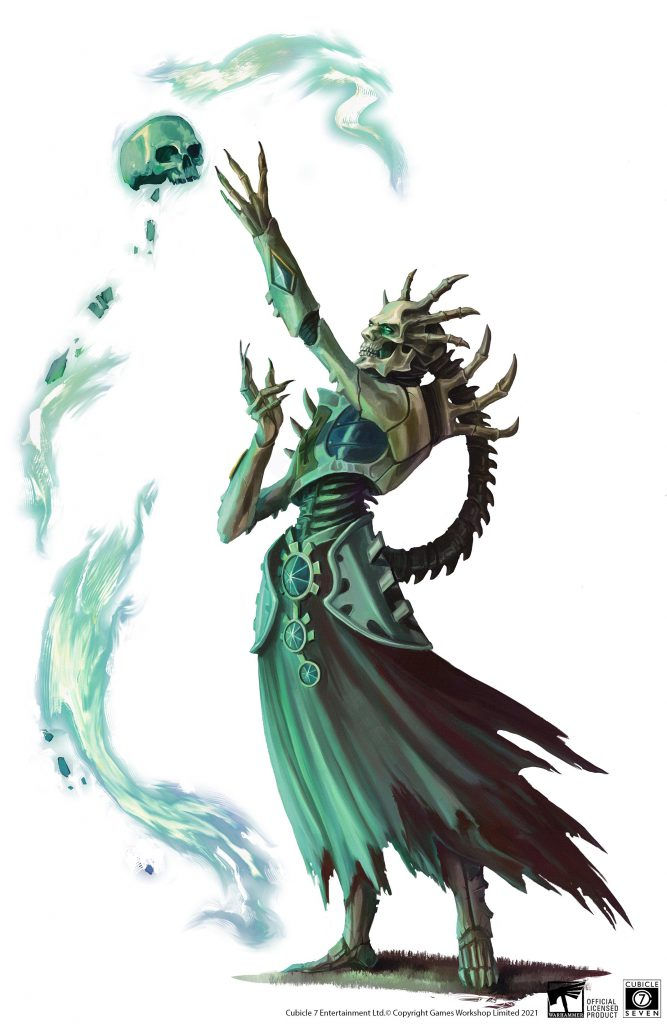 Mortisans are particularly focused on healing and enhancing Bonereapers. Otherwise, they can create what amounts to a hologram of themselves or punish mortals who either disobey them or break contracts made with the Bonereapers.
Mortisans are particularly focused on healing and enhancing Bonereapers. Otherwise, they can create what amounts to a hologram of themselves or punish mortals who either disobey them or break contracts made with the Bonereapers.
Mages of the Underworld have a few interesting tricks. Chained Fate links two targets; if one is healed or harmed, the other is also healed or harmed. There’s lots of potential for strange and cunning tactics with this Spell. They can also grant a physical creature the powers of a ghost or blow up a dying target’s soul!
Vampire magic covers a lot of the classic vampire abilities: hypnosis, becoming mist, or tracking terrified victims with unerring accuracy. They also get powers like Blood Siphon, which rips blood out of a target through the eyes and nostrils and feeds it to the vampire, in a move very reminiscent of Kain from the Legacy of Kain video game series.
I particularly enjoyed the Vampire Spell Amaranthine Orb, which is a fairly straightforward necromantic attack but sounds like a great ornament for a gothic house.
Finally, there are some Endless Spells, which are all ridiculously powerful and quite gruesome. My favourite being Corpsemare Stampede, where a herd of undead horses rampage across the battlefield, trampling everyone underfoot.
Chapter 6. Equipment
This chapter demonstrates once again the careful thought Cubicle 7 put into this setting. Trade is rare and precarious in the lands of the Dead; few commodities are needed by their denizens and treachery or conquest lurk around every corner.
Much like the living, the Dead may use magical currencies such as spiced blood, Purebone, or the coins placed on a corpse during burial. For creatures who place little value in material objects, trade may be in oaths or services rendered.
Weapons
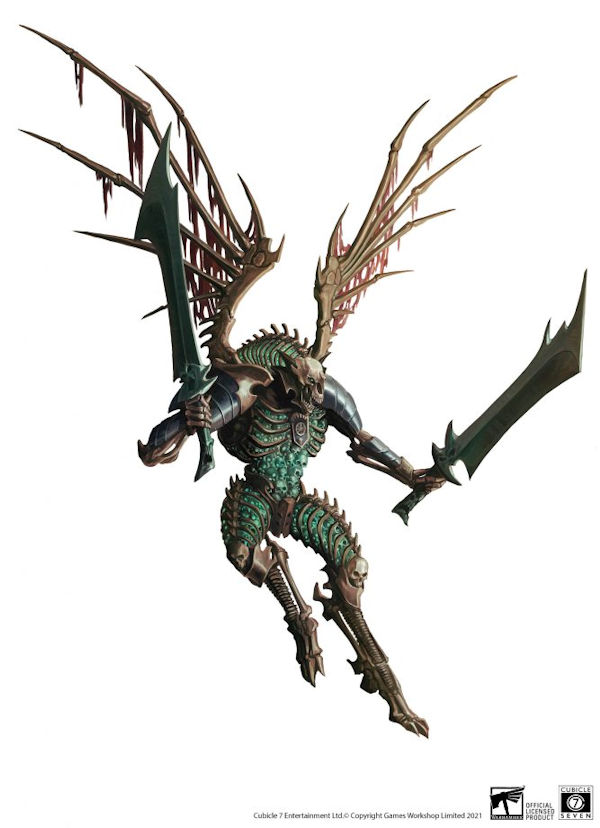 Weapons are still important to most Death factions, however. Nadirite weapons sap powerful foes’ will to fight, while Cursed weapons make wounded targets worse at avoiding harm, until they manage to pray the Curse away.
Weapons are still important to most Death factions, however. Nadirite weapons sap powerful foes’ will to fight, while Cursed weapons make wounded targets worse at avoiding harm, until they manage to pray the Curse away.
Other weapons steal or trap souls. One bell-like mace (the Death Knell) drains the life from all around it whenever it takes a mortal life.
Other undead trinkets include:
- The Fallen Kingdom’s Banner: the last banner of a lost empire. (Such an evocative idea.)
- The Mortality Glass: an hourglass that manipulates time, speeding up undead and slowing mortals.
- Nightmare Lantern: which empowers nighthaunts with necromantic vapours.
Artefacts
There are thirteen new magical Artefacts on offer (an oddly appropriate number for such a cursed Grand Faction). One is a trophy, the prestigious first prize in a boneshaping competition. (Which is almost cute.)
You can also acquire a (Spell)Book of Nagash, which holds incredible secrets of Death Magic, but will make you a target for every single follower of the Great Necromancer.
Also banned by Nagash, is possession of a Coat of Forbidden Heartbeats. These garments allow the wearer to experience the sensations of life again, but does not make them actually alive. Its wearers inevitably go irrevocably and violently insane. (Not to be confused with the Skinthief’s Raiment, a garment made from human skins, which allows the character to shapeshift into a seemingly living form.)
Then there are the deadly Corpse Candles and the grisly Decrepit Coronets. Finally, the Heartseeker’s Ring is as much a plot hook as an Artefact; it draws the wearer towards whatever it is they most desire.
Chapter 7. Endeavours and Rituals
Cubicle 7 know how to make downtime interesting. undead characters can start Death cults, go on a murder rampage (for their health), rob their own graves, curse a victim’s soul, or spread false superstitions amongst the living about their own weaknesses. (I love the idea of convincing mortals that your Wight character is deathly afraid of turnips or can be dissolved by water like the Wicked Witch of the West.)
Some Endeavours are specific to certain Species—Vampires can gather living followers by promising to turn them into vampires, ghouls can shake off their delusions, or sink further into them.
Undead can also team up to perform Dark Rituals, which are played out a bit like Skill Challenges from the more recent editions of D&D. (Multiple characters using certain Skills to generate enough successes to complete a group challenge.) Dark Rituals on offer include the creation of a new vampire, or an entire Ghoul Court, the stitching together of two corpses to make a hybrid undead abomination, or a good old-fashioned possession of an unwilling mortal.
Chapter 8. Death is Not the End
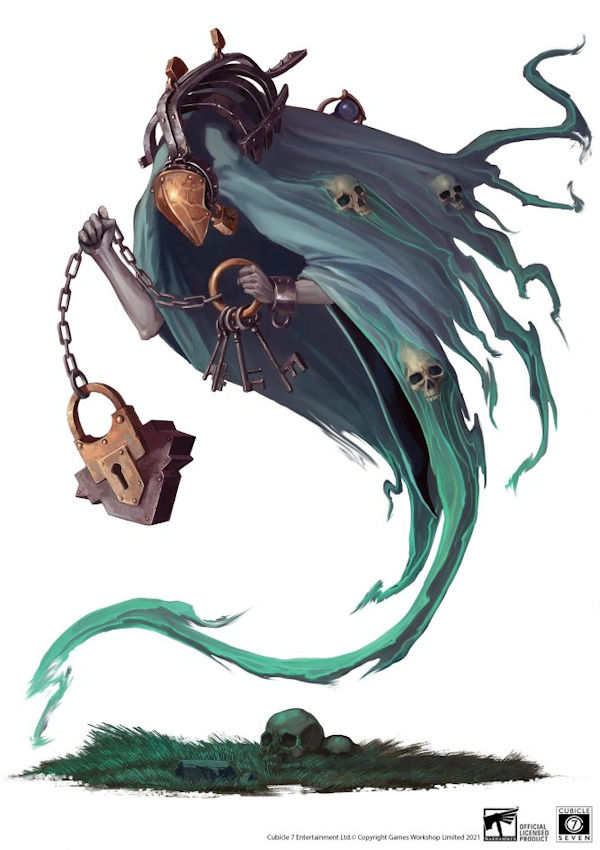 This chapter wraps things up with some thoughts on running and playing in Death campaigns. The writers acknowledge the very dark themes inherent to playing undead characters and emphasise the importance of player buy-in. They also consider what could motivate a tormented soul like a nighthaunt to continue their cursed existence instead of embracing the oblivion delivered by an enemy’s sword.
This chapter wraps things up with some thoughts on running and playing in Death campaigns. The writers acknowledge the very dark themes inherent to playing undead characters and emphasise the importance of player buy-in. They also consider what could motivate a tormented soul like a nighthaunt to continue their cursed existence instead of embracing the oblivion delivered by an enemy’s sword.
There’s a good piece of advice that says that peoples’ feelings about death may change due to circumstances in their own lives, and so it’s important to have something put in place that allows the group to adjust particular themes or story beats if need be.
There’s some discussion of the themes of free will, nostalgia, and monstrosity, all fairly interesting.
And there are some practical points about the in-fiction advantages of being undead. Undead creatures may have plots and goals that stretch across years or even centuries. They also don’t need to breathe, some of them can fly or pass-through solid objects and others can summon hordes of disposable followers. The writers encourage GMs to lean into these powers and give the players a chance to shine. This is something I really like about Soulbound as a whole—right from the start Player Characters are absolute badasses and the game is designed to let them show off and enjoy that.
Appendix: Allies and Enemies
This entry provides stats and descriptions for allies and foes of the Champions of Death. I’ve covered all these creatures before, so I won’t rehash them here.
There are a few interesting points about how particular members of the Grand Faction of Order might relate to the Dead. Long lived beings, such as ancient Hag Priestesses, might find more in common with eternal beings like vampires than with their younger mortal kin. Mortals who steal souls or avoid death are particularly hated Nagash and his loyal followers, even as the undead envy the powers of their mortal enemies. Lumineth Cathallars wield power over emotion, making them both more frightening to the Dead and more able to make some kind of connection with them.
I will add here that the PDF (and therefore, I presume, the physical book) comes with five pre-gen characters formed into a Death Binding, with a ready-made mission and set of relationships, so you can jump in and start playing with minimal effort, if you wish.
Final Thoughts
It’s fun to play the bad guys. It’s also fun to play horrific anti-heroes. This book provides enough detail to get you into the headspace of an undead being and enough cool powers to make it entertaining to play one.
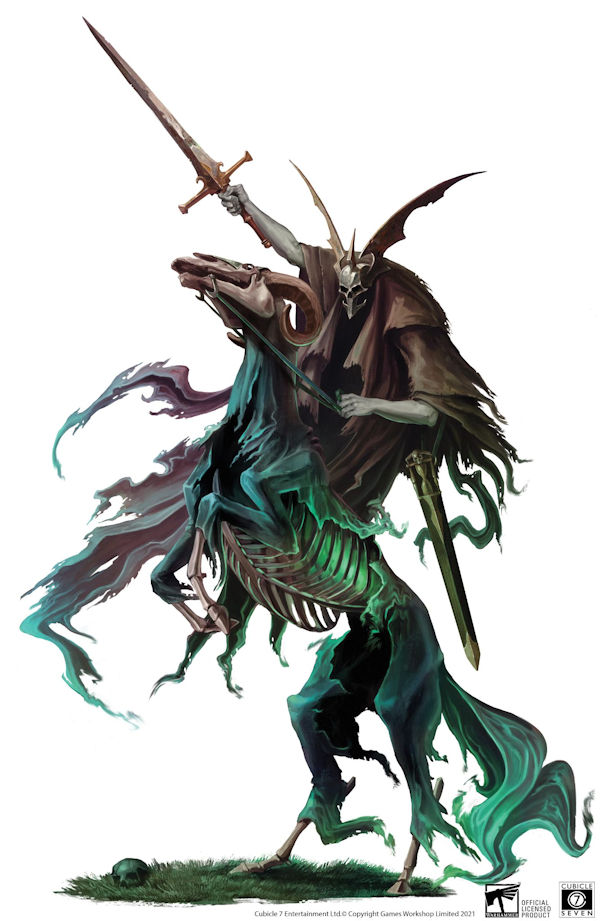 From the descriptions given, I think playing Champions of Death would feel distinctively different to playing Champions of Order. Less because your characters do bad things (as previously noted, Champions of Order can be ruthless mass-murderers or soul-eaters), but because their existence is endless, tyrannical and almost hopeless.
From the descriptions given, I think playing Champions of Death would feel distinctively different to playing Champions of Order. Less because your characters do bad things (as previously noted, Champions of Order can be ruthless mass-murderers or soul-eaters), but because their existence is endless, tyrannical and almost hopeless.
The only thing I would have liked more of, would have been descriptions of the geography of Shyish—a few necropoli, vampiric and Deathrattle kingdoms, Bonereaper outposts and one or two mortal cities that have surrendered to undead masters. The sub-faction descriptions partly address this, but it’s more a matter of wandering courts and competing legions than settled lands. Meanwhile Champions of Order offers a plethora of distinctive cities and settlements to explore. This is a minor gripe; it just means that if you wanted to do a Death campaign set in Shyish, you might need to do a bit more work.
Nonetheless, given all the plot hooks provided, you could get many months and perhaps even years of play out of this book, even if you only bought the core book to go with it.
Overall, I found this supplement to be the most fun I’ve had reading Soulbound since the core book. It recaptures that sense of having many cool options and the feeling of an over-the-top, power fantasy. Only this time instead of a pulpy, high fantasy romp, it’s a gloriously, gorily gothic rampage that breathes fresh, albeit foetid, life into the Dead.
If you want to play monsters in an epic fantasy world, this is the way to do it.
I received a free digital copy of this book in return for an honest review. For more on the Soulbound RPG check out my reviews of the core book and its supplements.


